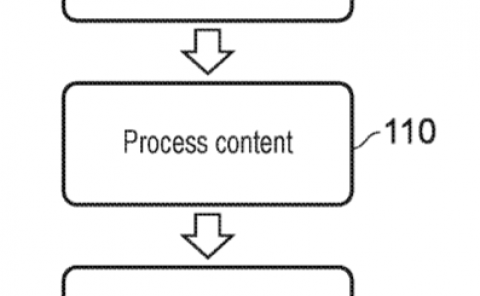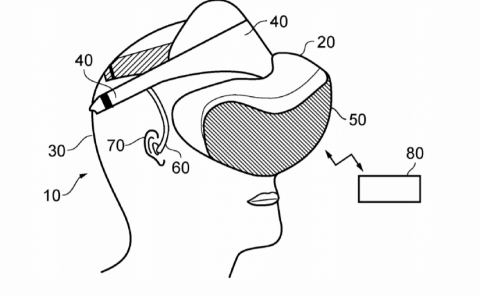Sony Patent | Head mounted display with multiple antennas
Patent: Head mounted display with multiple antennas
Publication Number: 10146302
Publication Date: 2018-12-04
Applicants: Sony

Abstract
A head-mounted display (HMD) is provided, including the following: a transceiver; a plurality of antenna arrays; a selector configured to determine which of the antenna arrays is active for wireless communication of data by the transceiver; a display configured to render video data received by the transceiver through the active antenna array.
Background
The video game industry has seen many changes over the years. As computing power has expanded, developers of video games have likewise created game software that takes advantage of these increases in computing power. To this end, video game developers have been coding games that incorporate sophisticated operations and mathematics to produce very detailed and engaging gaming experiences.
Example gaming platforms include the Sony Playstation.RTM., Sony Playstation2.RTM. (PS2), Sony Playstation3.RTM. (PS3), and Sony Playstation4.RTM. (PS4), each of which is sold in the form of a game console. As is well known, the game console is designed to connect to a display (typically a television) and enable user interaction through handheld controllers. The game console is designed with specialized processing hardware, including a CPU, a graphics synthesizer for processing intensive graphics operations, a vector unit for performing geometry transformations, and other glue hardware, firmware, and software. The game console may be further designed with an optical disc reader for receiving game discs for local play through the game console. Online gaming is also possible, where a user can interactively play against or with other users over the Internet. As game complexity continues to intrigue players, game and hardware manufacturers have continued to innovate to enable additional interactivity and computer programs.
A growing trend in the computer gaming industry is to develop games that increase the interaction between the user and the gaming system. One way of accomplishing a richer interactive experience is to use wireless game controllers whose movement is tracked by the gaming system in order to track the player’s movements and use these movements as inputs for the game. Generally speaking, gesture input refers to having an electronic device such as a computing system, video game console, smart appliance, etc., react to some gesture made by the player and captured by the electronic device.
Another way of accomplishing a more immersive interactive experience is to use a head-mounted display. A head-mounted display is worn by the user and can be configured to present various graphics, such as a view of a virtual space. The graphics presented on a head-mounted display can cover a large portion or even all of a user’s field of view. Hence, a head-mounted display can provide a visually immersive experience to the user.
A head-mounted display (HMD) provides an immersive virtual reality experience, as the HMD renders a real-time view of the virtual environment in a manner that is responsive to the user’s movements. The user wearing an HMD is afforded freedom of movement in all directions, and accordingly can be provided a view of the virtual environment in all directions via the HMD. However, the processing resources required to generate the video for rendering on the HMD are considerable and therefore handled by a separate computing device, such as a personal computer or a game console. The computing device generates the video for rendering to the HMD, and transmits the video to the HMD.
To provide a high fidelity experience, it is desirable to provide high quality video (e.g. at high resolution and frame rate). However, such video entails transmission of large amounts of data, requiring high bandwidth and a stable connection. Thus, current systems for HMD rendering use a wired connection to transfer data from the computing device to the HMD, as this affords the requisite bandwidth and connection stability. However, the presence of a wire that connects to the HMD can be bothersome to the user, as it may contact the user and detract from the immersive experience of using the HMD. Furthermore, the wired connection may inhibit the user’s freedom of movement, as the user must be mindful of not over-extending the wire, and must avoid any movement which might cause disconnection or damage the wire. Furthermore, the presence of the wire presents a tripping hazard, which is amplified by the fact that the user cannot see the real environment while using the HMD.
Summary
Implementations of the present disclosure include devices, methods and systems relating to RF beamforming for a head mounted display.
In some implementations, a method is provided, including the following method operations: receiving captured images of an interactive environment in which a head-mounted display (HMD) is disposed; receiving inertial data processed from at least one inertial sensor of the HMD; analyzing the captured images and the inertial data to determine a predicted future location of the HMD; using the predicted future location of the HMD to adjust a beamforming direction of an RF transceiver towards the predicted future location of the HMD.
In some implementations, analyzing the captured images and the inertial data includes identifying movement of the HMD, the predicted future location of the HMD being determined using the identified movement of the HMD.
In some implementations, identifying movement of the HMD includes determining a motion vector of the HMD, the predicted future location of the HMD being determined by applying the motion vector of the HMD to a current location of the HMD.
In some implementations, a magnitude of the motion vector identifies a speed of the movement of the HMD, and wherein a direction of the motion vector identifies a direction of the movement of the HMD.
In some implementations, the method further includes: adjusting an angular spread of the RF transceiver based on the speed of the movement of the HMD.
In some implementations, the angular spread increases with increasing speed of the movement of the HMD.
In some implementations, identifying movement of the HMD includes identifying translational movement and/or rotational movement of the HMD; wherein determining the motion vector includes determining an acceleration of the translational movement and/or the rotational movement.
In some implementations, the RF transceiver includes a phased array of RF emitters; wherein adjusting the beamforming direction of the RF transceiver includes generating transceiver control data that is configured to cause adjustment of a phase or amplitude of at least one of the RF emitters of the phased array.
In some implementations, the at least one inertial sensor of the HMD includes one or more of an accelerometer, a gyroscope, or a magnetometer.
In some implementations, the HMD includes a plurality of lights; wherein analyzing the captured images includes identifying one or more of the plurality of lights in the captured images.
In some implementations, a system is provided, including: a head-mounted display (HMD), the HMD having at least one inertial sensor configured to generate inertial data; a camera configured to capture images of an interactive environment in which the HMD is disposed; an RF transceiver; a computer configured to analyze the captured images and the inertial data to determine a predicted future location of the HMD, and use the predicted future location of the HMD to adjust a beamforming direction of the RF transceiver towards the predicted future location of the HMD.



